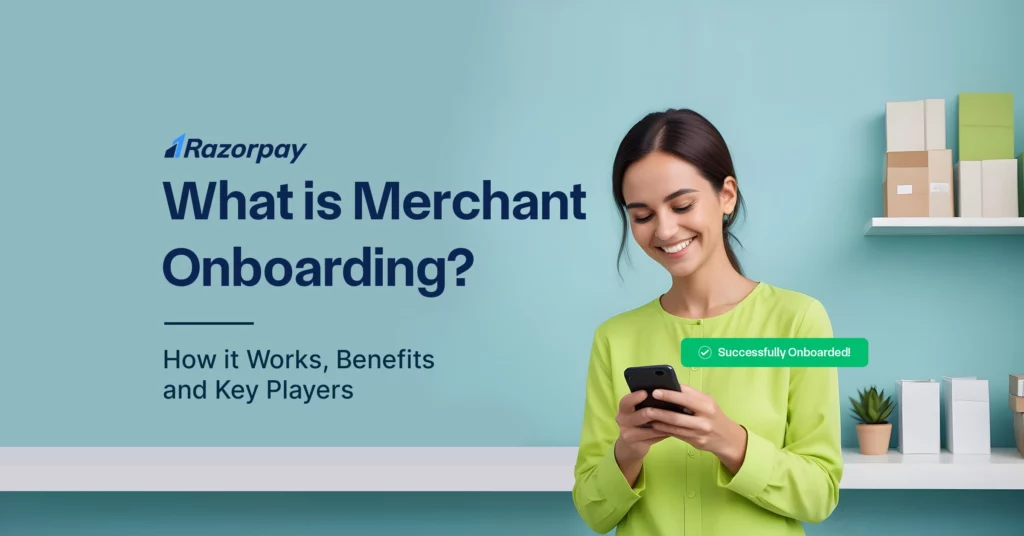In today’s competitive landscape, secure payment processing is paramount for businesses. Merchant onboarding plays a crucial role by integrating a business with payment service providers or gateways. This process establishes an efficient and compliant payment system, improving customer trust, reducing fraud risks, and smoothening transactions. Businesses should approach onboarding with careful planning to tailor their payment setup.
Let’s understand what is a merchant account, merchant onboarding meaning, how it works, and its benefits.
Table of Contents
What is Merchant Onboarding?
Merchant onboarding is the process of a payment company allowing a business to manage customer payments securely. This process significantly impacts a business’s operational efficiency and customer experience.
A poorly executed onboarding process leads to delayed or failed transactions, increased risk of fraud, and non-compliance with industry regulations. This damages the business’s reputation and results in financial penalties or customer loss.
How Does the Merchant Onboarding Process Work?
-
Pre-screening: Businesses evaluate potential PSPs or gateways that align with their needs.
-
Identity Checks: Rigorous identity verification ensures the business’s legitimacy and minimizes fraud risks.
-
Underwriting: Assess the business’s financial stability, creditworthiness, and risk profile.
-
Merchant History Screening: Examine the business’s past performance. Prevalent issues help gauge its reliability and trustworthiness.
-
Business and Operational Analysis: Understands the business model, operations, and scalability to tailor a payment solution.
-
Compliance Setup: Compliance with industry regulations (such as anti-money laundering and data protection) is non-negotiable.
-
Web Content Analysis: The business’s online presence is scrutinized, including website content and security protocols.
This process is critical for security and compliance. It enables ISO agents and merchants to maintain secure payment environments, fostering trust and efficient transactions.
Benefits of Merchant Onboarding in India
Merchant and sub-merchant onboarding plays a crucial role. Let’s explore their advantages –
-
Diverse Payment Methods: Merchant onboarding allows businesses to accept payments through various channels, including credit/debit cards, digital wallets, and NetBanking. This flexibility safeguards customers’ ability to pay using their preferred method.
-
Speed and simplicity: Fast and efficient payment options streamline transactions, making them convenient for both customers and merchants.
-
Security and Trust: Digital payment platforms offer robust security features. Businesses can rest assured that their transactions are encrypted.
-
Transaction Monitoring: Signing up for a payment processing platform provides businesses with tools to monitor and track transactions. Real-time insights help them analyze sales patterns, identify peak hours, and optimize operations.
Merchant Onboarding: Essential Players and Components
1. Merchants
They are businesses or service providers that aim to accept payments from customers. They establish relationships with payment service providers (PSPs) or merchant payment gateways to facilitate transactions across various channels.
2. Payment Gateways
They serve as technology platforms that facilitate secure data transfer between businesses and PSPs or acquiring banks.
Key Features –
-
They ensure that sensitive financial data (such as credit card information) is encrypted during transmission.
-
They establish a secure channel for data exchange between the merchant website / POS system and the PSP / acquiring bank.
3. Payment Service Providers (PSPs)
These companies offer payment processing solutions to businesses. Their roles include –
-
PSPs handle authorization, clearing, and settlement of transactions. They ensure that payments flow smoothly from the customer’s to the merchant’s account.
-
PSPs adhere to industry regulations and standards, ensuring you meet legal requirements.
-
Some PSPs provide additional services like fraud detection, risk management, and reporting.
4. Acquiring Banks
Acquiring banks collaborate with PSPs during merchant onboarding. Their responsibilities include –
-
Acquiring banks assess the risk associated with your business. They evaluate business stability, financial health, and industry type.
-
They determine the level of risk your business poses and set appropriate transaction limits.
-
Acquiring banks ensures that you comply with legal and regulatory requirements.
5. Issuing Banks
These financial institutions issue payment cards to consumers. Their roles include-
-
Issuing banks approve or decline transactions based on available funds, credit limits, and security checks.
-
They verify that the customer has sufficient funds to cover the transaction.
-
They transfer funds to acquiring banks after successful transactions.
6. Regulatory Authorities and Industry Bodies
Entities like the Payment Card Industry Security Standards Council (PCI SSC) are critical in enforcing payment processing regulations. Their focus is on customer protection, data security, and maintaining the integrity of the payment ecosystem.
7. Card Networks
Card networks like Visa and Mastercard set rules governing card transactions. They facilitate communication and settlement between acquiring and issuing banks, ensuring seamless payment processing.
What Documentation is Required for Merchant Onboarding?
-
Proof of Identity: All individuals involved in the company (owners/directors/partners) must provide valid proof of identity.
-
Address Proof: Utility bills or lease agreements serve as evidence of the business address.
-
Registration Documents: These include incorporation papers or registration certificates.
-
Income Tax Returns: PSPs often require income tax returns from the previous year(s). These help assess your business’s financial health.
-
Salary Slips: Salary slips serve as employment evidence for businesses with employees. They validate the company’s workforce and stability.
-
Bank Statements: They are essential for confirming financial stability cash flow and overall financial health.
Remember that requirements may vary based on industry and transaction volume. Businesses must collaborate closely with the payment processor or ISO agent to streamline the process.
Merchant KYC Onboarding Process
The Know Your Customer (KYC) process is a critical regulatory requirement employed by financial institutions, PSPs, and various businesses. Its primary objective is to prevent money laundering, terrorist financing, and fraudulent activities.
Let’s understand how KYC is pivotal in the merchant onboarding process –
-
KYC helps assess the risk associated with businesses. By verifying legitimacy, you can make informed decisions about approving or declining the business’s application.
-
It ensures compliance with industry regulations. It prevents unauthorized or fraudulent activities, safeguarding both businesses and customers.
-
A robust KYC process builds trust between merchants, PSPs, and customers. It shows a commitment to security and transparency.
The typical KYC process during merchant onboarding involves the following steps-
Identification
-
Merchants must submit relevant documents, including individual or business KYC forms.
-
Identification of the ultimate beneficial owners of the business is the next step. This ensures transparency and prevents misuse.
Verification
-
Verify the business’s identity using government-issued IDs, passports, or other valid documents.
-
Then, validate the business’s legal existence, ownership structure, and operational details.
Risk Assessment
-
Screen for politically exposed persons (PEPs) associated with the business.
-
Try to discover the negative news or legal issues related to the business.
-
Check if the business is involved in any sanctioned activities.
Ongoing Monitoring
-
Continuously monitor transactions for suspicious activity.
-
Regularly reassess merchant profiles to detect any changes in risk.
Merchant Onboarding Risk Management
Identity Verification
Unauthorized or fraudulent merchants might provide fraudulent information during onboarding. Hence, implementing a robust identity verification process via document verification, biometric authentication, and background checks is crucial.
Compliance with Regulatory Standards
The onboarding process should adhere to relevant legal and regulatory requirements to avoid legal consequences. These rules vary based on the industry, service type, and jurisdiction. You should conduct regular audits to ensure ongoing compliance.
Transaction Monitoring
-
To prevent fraud, you must closely monitor merchant transaction patterns post-onboarding. Look out for chargebacks, refunds, disputes, and money laundering.
-
Implement real-time monitoring systems to detect anomalies, like sudden spikes in volume or high-risk transactions, and set alert thresholds for investigation.
Data Security and Privacy
-
Prioritise data security throughout and after onboarding to safeguard sensitive merchant and customer data from unauthorized access or misuse. This involves encryption, secure storage, and compliant practices.
-
Encrypt data using cryptographic methods to render it unreadable for unauthorized parties.
-
Store data securely on servers, databases, or cloud services. Adhere to data protection regulations like GDPR or PCI-DSS.
-
Ensure regular security audits and vulnerability assessments.
Automated Risk Scoring
These models assess and manage merchant risk. Parameters like transaction history, business type, and location are evaluated.
-
A low-risk score suggests reliability and compliance, allowing acceptance without extra verification.
-
A high score indicates risk, leading to rejection or further scrutiny.
-
A medium score warrants a closer review.
Due Diligence on High-Risk Industries
-
Conduct thorough due diligence on merchants to mitigate risk.
-
Implement industry-specific risk management protocols for the gambling, adult entertainment, cryptocurrency, and e-commerce sectors.
-
Opt for enhanced KYC measures, like stricter transaction limits, fees, and detailed reporting.
Strengthening Customer Authentication
To safeguard merchant accounts and payment systems, you must include multi-factor authentication (MFA) and stringent password policies. MFA requires merchants to provide at least two forms of authentication: something they know (e.g., password or PIN) and something they have (e.g., token or card). Strong password policies mandate complex, unique passwords that are changed regularly.
Ongoing Monitoring and Reviews
You should establish ongoing monitoring and review mechanisms. These may include updating merchant profiles, conducting periodic reviews, and performing risk assessments.
-
Updating profiles involves collecting and maintaining information on the merchant’s contact details, business type, and transaction history.
-
Periodic reviews verify and validate provided documents.
-
Risk assessments adjust protocols based on updated information.
Training and Awareness
-
It is important to provide comprehensive training and awareness for the staff involved in the onboarding process and keep them informed about emerging risks and fraud trends.
-
Provide guidelines, manuals, or checklists for onboarding and conducting workshops/webinars/courses on the best practices and standards for risk management
-
You must share updates, alerts, or reports on the latest risks and frauds in the industry or market.
Incident Response Plan
You must develop and regularly update an incident response plan that outlines the steps to be taken in case of a security incident and conduct drills to ensure the plan’s effectiveness. These plans should define the roles and responsibilities of the staff, identify the potential scenarios and impacts of the incidents, and establish the procedures and protocols for various tasks.
How to Improve Merchant Onboarding?
A smooth onboarding procedure can increase customer satisfaction, loyalty, and retention. Here are some tips on how to proceed –
-
Clear communication: Inform merchants about the onboarding process, the expected timeline, and the possible challenges they may face.
-
Gather all required documents: Provide merchants with a checklist of the documents they must submit for verification and approval.
-
Follow up proactively: Stay in touch with merchants throughout the onboarding process, updating them on the status of their applications and providing assistance if needed.
Why You Should Automate Your Merchant Onboarding Process
Manual merchant onboarding can be tedious and risky, as it may involve human errors, delays, and inconsistencies. Missing or incorrect information can lead to legal troubles, fraud, chargebacks, and reputational damage for both you and the merchant.
That is why many payment service providers have opted to automate their merchant onboarding process using advanced technology and software.
Automation can streamline and simplify the process, ensuring that all the necessary steps are completed accurately. It can also reduce operational costs, enhance security, and improve customer satisfaction.
Conclusion
Merchant onboarding is vital for businesses in today’s payment landscape. It establishes secure payment processing, enhances customer trust, and reduces fraud risks. Proper onboarding ensures compliance with regulations and fosters efficient transactions. With clear communication, proactive follow-up, and automation, businesses can streamline the process and focus on growth.
Frequently Asked Questions (FAQs)
1. How long does the merchant onboarding process usually take?
The merchant onboarding process can vary in length depending on the payment service provider, the type and size of the business, and the level of risk involved. Generally, it can take anywhere from a few minutes to a few weeks to complete the process.
2. What are the common challenges businesses face during the merchant onboarding process?
The 2 most common challenges businesses face during the merchant onboarding process are –
-
Providing accurate information and documents for verification
-
Meeting the compliance requirements and standards of the payment industry, such as PCI-DSS, KYC, and AML
3. Are there any fees associated with merchant onboarding?
The fees associated with merchant onboarding depend on the PSP and the type of payment processing solution the business chooses. Some may levy a one-time setup fee, a monthly fee, a per-transaction charge, or a combination of these.
4. Can businesses use third-party services to assist with merchant onboarding?
Yes, you can use third-party services to assist with merchant onboarding, such as identity verification, document collection, risk assessment, and compliance management. These services can streamline onboarding and reduce errors and fraud.
5. What happens after the merchant onboarding is complete?
After the merchant onboarding is complete, the business can start accepting and processing payments from customers through online, in-store, or mobile channels. They can also access the PSP’s dashboard, reports, and analytics to monitor and manage their transactions.


